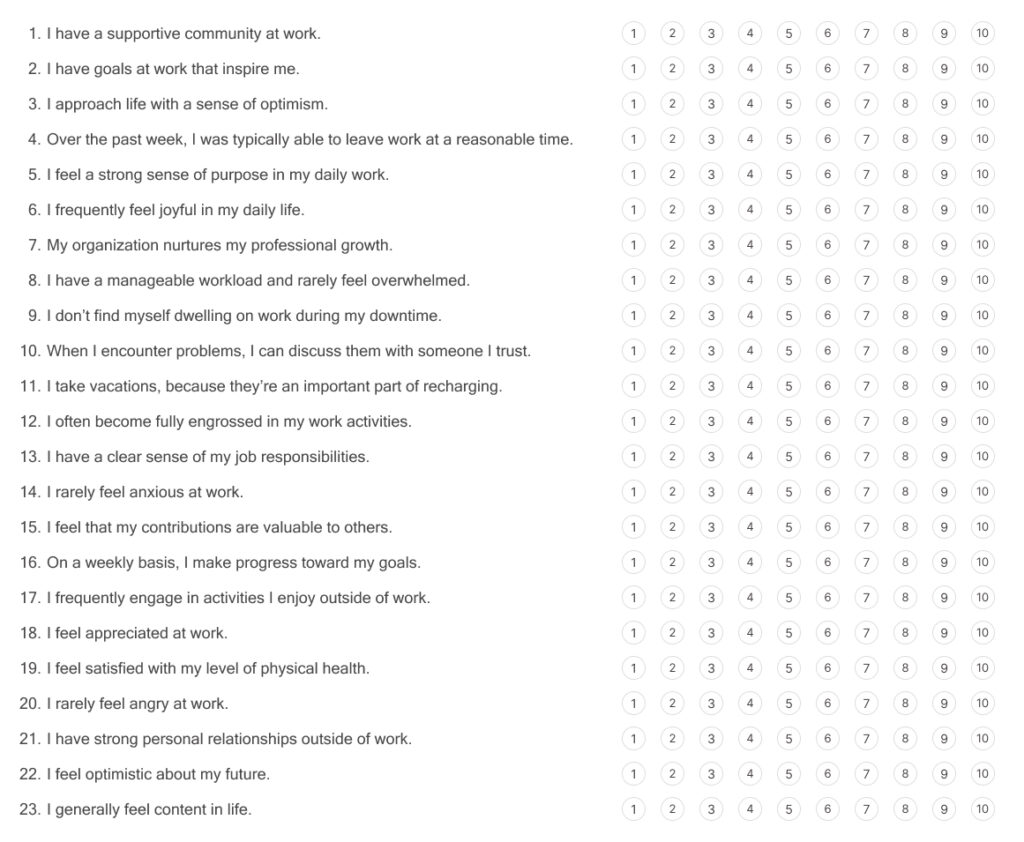Today, organizations are recognizing the reciprocal relationship between work and well-being. Employee well-being influences how well people perform their roles. And employees’ experience at work shapes their overall well-being. So, strengthening employee well-being is crucial to organizational success.
Most companies have substantial room for improvement in this vital area. According to Gallup, 35% of employees say they’re thriving in life while 56% report that they’re struggling. And 9% say they’re suffering. Among those who are struggling, a Deloitte survey found that heavy workloads, high stress levels, and long work hours are the main culprits.
Improving well-being means first figuring out how to measure it. HR leaders are increasingly realizing they must track employee well-being indicators like any other KPI. Measuring well-being can help you make the business case for wellness initiatives and monitor their success. In this article, we’ll share effective strategies and tools for measuring well-being.
Table of Contents
1. Defining Employee Well-Being
2. Key Tools for Measuring Well-Being
3. Implementing Well-Being Assessments
4. Interpreting Assessment Results
5. Taking Action on Well-Being Data
6. Challenges and Considerations
Defining Employee Well-Being

Employee well-being has a multifaceted nature, comprising mental, physical, and emotional wellness. Financial wellness, job and career satisfaction, the state of one’s physical and mental health, the ability to lead a fulfilling life outside of work, and the sense of well-being at work all influence one’s overall well-being.
When well-being declines, productivity typically decreases while healthcare costs rise, says Deloitte. This lost productivity costs U.S. companies $150 billion a year, they note.
Measuring well-being is crucial for a healthy work environment. By learning about particular well-being gaps, you can work to holistically improve wellness, including employee mental health. As you take these steps, you’ll help each person fully engage with their work.
Key Tools for Measuring Well-Being

Let’s examine a few useful tools for assessing employees’ well-being, from wellness evaluations to job satisfaction surveys.
The PERMA Model
The PERMA model, developed by Dr. Seligman, former president of the American Psychological Association, outlines 5 key dimensions of well-being:
- Positive emotion. This encompasses emotions like gratitude and acceptance for the past, enjoyment of the present, and hope and optimism in the future.
- Engagement. When people are fully engaged in what they’re doing, the activity becomes its own reward. They experience a state of “flow,” in which they become fully absorbed in what they’re doing, as the Penn Arts & Sciences Positive Psychology Centre explains.
- Relationships. A sense of belonging, strong bonds with other people, and a sense of joint accomplishment all make work and life feel more worthwhile. Having a robust social support system at work will greatly enhance people’s emotional well-being.
- Meaning. People want to have a sense that their work, and other dimensions of life, have value to others. Even if they find meaning in various pursuits outside of work, they also want to know that through their job, they’re contributing value to society.
- Accomplishment. This means cultivating a sense of mastery of one’s work, expanding one’s capabilities and enhancing their prospects. (It can also apply to other dimensions of life—mastering relationship skills or hobbies, for example.)
The PERMA Profiler and the Workplace PERMA Profiler can help people determine their level of well-being, making them valuable tools for organizations.
Warwick-Edinburgh Mental Well-Being Scale
This 14-item tool measures subjective well-being in the form of a simple questionnaire. Questions deal with topics like these:
- Optimism about the future
- Feelings of usefulness
- Ability to think clearly
- Interest in other people
- Energy level
- Ability to relax
- Feelings about oneself
Along with their score, participants gain specific pointers about how to improve their individual well-being.
Well-Being Questionnaire
You can use subjective measures like employee surveys to gain self-reported data. Here, we share a questionnaire with items similar to those in the measures discussed above.
On a scale of 1–10 (with 1 being the lowest and 10 being the highest), rate how strongly you agree with each of these statements.

Surveys can cover particular themes. For example, a job satisfaction survey can provide insights on wellness. Also ask about employees’ satisfaction with existing wellness initiatives and developmental initiatives.
Analytics Software
“Hard data” on topics like engagement can also lend insight about well-being. As CIO.com says, while engagement isn’t the same thing as wellness, it can be a strong indicator of well-being. Employees who feel enthusiastic and energetic are more likely to be thriving in work and in life.
You can use HR analytics data from your existing performance management or HRM system to track well-being indicators. For example, look at factors like these, as Deloitte suggests:
- Percentage of vacation time used
- Overtime hours contributed
- Volume of work communications sent on weekends or non-work hours
- Whether medical needs are rising or decreasing
For example, if employees are using a low percentage of vacation time, they may not be relaxing and recharging enough.
Look at indicators like participation levels, task completion rates, and changes in the quality of work as well. They can provide important clues about employees’ degree of wellness.
A variety of other tools exist as well. Some focus more strongly on workplace indicators of well-being, while others deal with holistic wellness.
- Index of Psychological Well-Being at Work, with questions about the meaning people find in their jobs, relationships at work, and related topics.
- The WARR Scale of Job-Related Affective Well-Being, with questions about job-related emotions, sense of self-efficacy, and similar topics.
- The Workplace Well-Being Questionnaire, with questions on feeling respected and cared for at work, along with other components of job satisfaction.
- Gallup’s CliftonStrengths tool: While not solely a measure of well-being, the results can indicate an employee’s level of wellness along with key ways to improve it, according to Gallup. This tool measures career, social, financial, physical, and community well-being to assess whether employees are thriving at work.
Implementing Well-Being Assessments

Successfully integrating these assessments into the workplace will ensure they deliver valuable data. Let’s discuss some practical steps this involves.
Determining Frequency
You don’t want to overwhelm employees with constant wellness assessments. At the same time, you do want to gain consistent data so you can accurately track well-being patterns. Offering a monthly questionnaire that they can complete in 10–15 minutes will strike the right balance.
Handling Anonymity
We advise keeping job satisfaction surveys anonymous. Employees may worry that stigma will be attached to results that put their level of well-being in question. Make sure they know how the data will be used (e.g., that it will be aggregated and used to design workplace programs).
When utilizing tools like the PERMA model, you can collect aggregated data from all employees to protect their privacy. At the same time, you can allow each person to see how they scored, so they’ll derive individual benefits from the tool.
Boosting Participation Rates
Prompt managers to talk about the importance of wellness assessments with their team. Provide examples of real changes your organization has made based on the survey input. This will boost investment in completing these questionnaires. Use software that gives reminders, too, so the survey invite won’t get lost in email inboxes.
Interpreting Assessment Results
To analyze and understand the results from these tools as accurately as possible, use a clear rubric for the scores. Tools developed by psychologists, like the Workplace PERMA Profiler, offer a built-in rubric to make sense of scores. If developing your own questionnaires, use software that helps you understand what different scores mean or consider consulting with an organizational psychologist.
Remember that well-being can vary over time. Consider whether organizational changes or the business environment may have affected results for any given questionnaire. For example, well-being might rise as teams complete a big project, but drop as your organization undergoes some restructuring. At the individual level, personal life changes can cause well-being to fluctuate dramatically, too. Or, if an employee had a particularly busy week, answers might not reflect her typical level of well-being. That’s why tracking data over time is so important.
Taking Action on Well-Being Data
Strive to translate the results of your well-being assessments into actionable improvements.
Let’s discuss a few potential interventions or policy changes you could make.
Strengthening Wellness Offerings
“Although 87 percent of employees have access to mental and emotional well-being offerings, only 23 percent of employees use them,” says SHRM, citing a Gartner study. Too often, companies waste resources on ineffective initiatives while neglecting more promising solutions.
For example, healthcare offerings have grown stronger, but employees still want a workplace culture that openly discusses and prioritizes mental health.
Based on feedback from employee surveys, strengthen your wellness offerings. Make sure your benefits package covers what they truly need.
Improving Work Environment, Culture, and Relationships
Survey results can highlight how areas like culture and relationships need to improve. For example, training managers to lower stress levels among their team can pay dividends, enhancing team culture, relationships, and overall wellness.
You could also reconsider how you structure work. For example, if feedback shows that employees don’t have enough social time at work, you can schedule collaborative sessions (either in-person or online). Building in more opportunities for coworkers to get to know one another could make work more enriching and strengthen the culture.
Disclosing Your Data
Share your findings with employees, along with the steps you’ll take to address them. You might also consider taking this transparency one step further. Deloitte suggests an unconventional new use of well-being metrics: publicly disclosing them to build your employer brand. Offering this level of transparency can build trust with prospective recruits. Plus, Deloitte emphasizes that when leaders are transparent, employees tend to self-report their well-being much more highly. On the other hand, if your numbers aren’t quite where you want them to be, you can consider implementing this idea down the road.
Chevron sets a strong example for leveraging wellness data. At Chevron, different business units aggregate their own wellness data. Then, they set their own well-being goals, reports the Society for Human Resource Management (SHRM). When sharing the survey results, ask employees for insights on ways to improve.
Challenges and Considerations
Several common challenges can affect the measurement of well-being. We’ll discuss factors that can affect the accuracy of results and how to address them.
Cultural Differences
Researchers in Japan have developed a scale that measures eudaimonic well-being, which has been defined as “living a life of virtue in pursuit of excellence.” Eudaimonic well-being centres on the ability to serve others rather than to derive personal enjoyment from work. (Meanwhile, western concepts of well-being often centre more strongly on hedonic well-being, although today’s scales increasingly consider both types of well-being.) Through the University of Tokyo Occupational Mental Health (TOMH) well-being scale, researchers have created a tool that may more accurately measure well-being in collectivist cultures. If you operate in such a culture, consider using an assessment like this one.
Response Bias
Social desirability bias can lead respondents to select answers that represent what they believe they should do, or how they want to feel. This especially occurs when dealing with sensitive topics. To ward off this form of bias, phrase questions carefully, avoiding any implication of judgment. Remind participants that no one will see their answers but them, too.
Additionally, presenting questions in a random order will help ensure that the answer to one doesn’t influence the answer to the next.
By measuring employee well-being, you’ll understand how to better support your people. Then, by effectively using the right tools and strategies, you can steadily enhance well-being. In turn, you’ll strengthen other key dimensions of work like engagement and productivity. Moreover, when you cultivate a culture focused on well-being, you’ll build a strong sense of trust and connection with your valued employees. As a result, you’ll enhance job satisfaction and loyalty, encouraging employees to stay with your company for a long time to come.
Learn how software can support your efforts to improve employee wellness. Demo our product!
